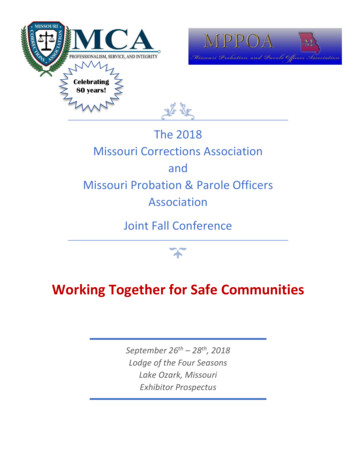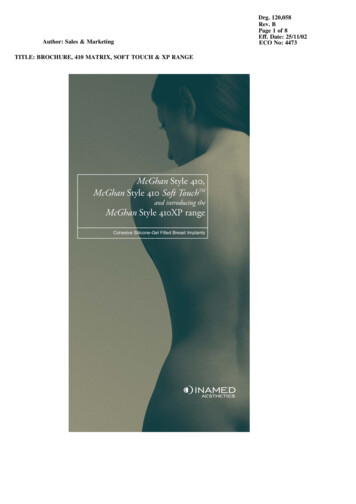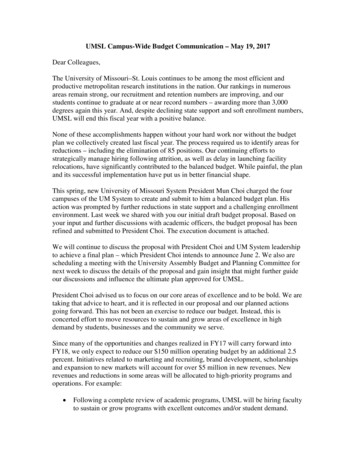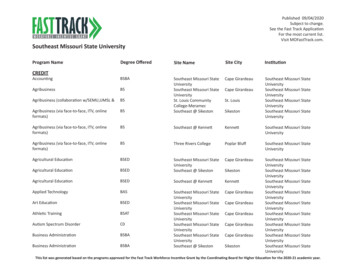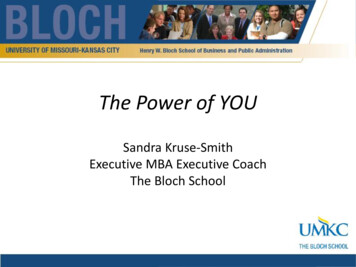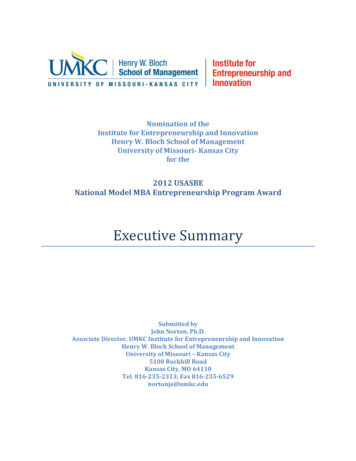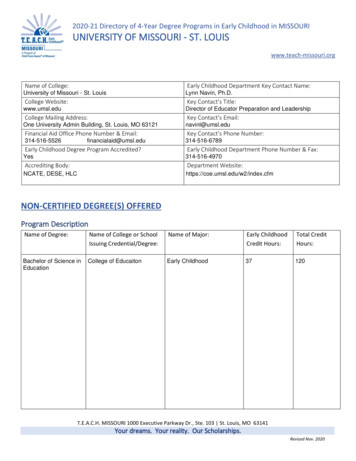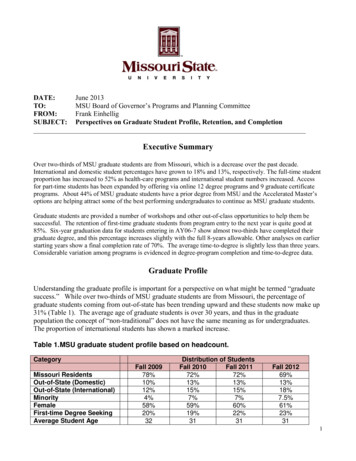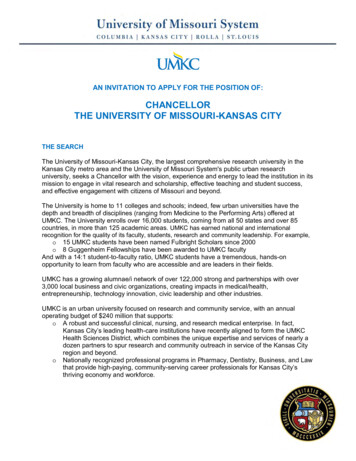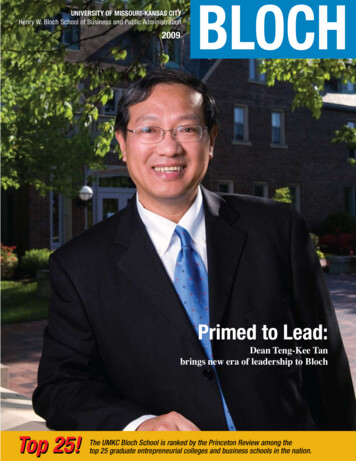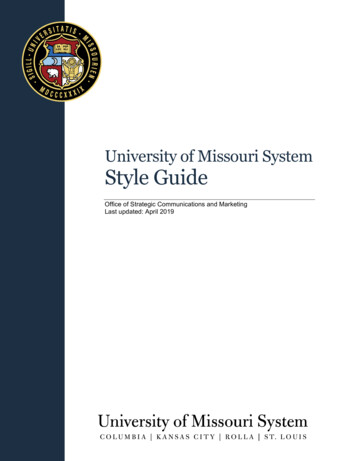
Transcription
University of Missouri SystemStyle GuideOffice of Strategic Communications and MarketingLast updated: April 2019
CONTENTSsection 1 MANAGEMENT . 2section 2 EDITORIAL STYLE . 32.1.Default Style . 32.2.University of Missouri-Specific Style Guidelines . 32.3.General Style Guidelines . 6section 3 CORRESPONDENCE GUIDELINES . 123.1.Correspondence Sample . 123.2.Memorandum Sample . 133.3.President’s Personal Notes, Memos and Letters . 143.4.Correspondence to Members of the Board, General Officers and Elected Officials . 14section 4 GRAPHIC STANDARDS . 164.1.Preferred Typeface. 164.2.Colors . 164.3.Templates. 174.4.Letterhead and Publications. 17section 5 THE OFFICIAL UM SYSTEM SEAL . 185.1.History . 185.2.Guidelines for Using the Seal. 185.3.Licensed Uses of the Seal . 195.4.Downloading the Seal and Campus Logos . 205.5.Secondary Symbols Policy . 205.6.Seal Do’s and Don’ts . 20section 6 DIGITAL PRESENTATION STANDARDS . 236.1.Presentation Guidelines . 236.2.Slide Content Suggestions . 23section 7 WEB COMMUNICATIONS STANDARDS . 247.1.Accessibility/508 Compliance. 247.2.Banner Design. 247.3.Required Elements of a UM System Website . 247.4.Colors . 257.5.CSS . 257.6.Fonts . 257.7.Footer . 267.8.Hyperlinks. 267.9.Modification of the UM System Website Design . 277.10.Navigation . 277.11.Title . 287.12.The UM System’s Official URL Shortener . 287.13.XHTML . 28section 8 RESOURCES AND CONTACTS. 29Last updated: 04/15/20191 Page
section 1 MANAGEMENTThe University of Missouri System Office of Strategic Communications and Marketing develops and maintainsstyle guidelines for print and electronic publications to protect the value and reputation of the University ofMissouri System and to ensure consistency for official publications. A designated brand manager, appointedfrom among the strategic communication professionals who work in University Relations, maintains this styleguide. The guide covers editorial, correspondence and graphic guidelines for types of communication includingbut not limited to: Agendas, Brochures/programs, Emails, Fact sheets, Flyers, Invitations, Letters, Memoranda, Presentation materials (e.g., PowerPoint presentations), Reports, Social media and Web.Questions about this style guide, or related guidelines or templates, should be directed to the Office ofStrategic Communications and Marketing. Jump to the Resources and Contacts section for details.Last updated: 04/15/20192 Page
section 2 EDITORIAL STYLE2.1.Default StyleIn general, use The Associated Press Stylebook (AP Stylebook) when a style question is not addressed in thisguide. Where this guide conflicts with the AP Stylebook, this guide prevails.Some professional disciplines require use of a different guide than the AP Stylebook. If that is the case for yourdiscipline, use whatever style guide is appropriate. Consistency is paramount.2.2.University of Missouri-Specific Style GuidelinesBoard of Curators. On first reference: the University of Missouri Board of Curators or The Curators of theUniversity of Missouri (the legal and official name). Subsequent references may use Board, Curators or Boardof Curators. Uppercase when referring to the University’s Board of Curators. Lowercase when referring to anindividual member, unless it is preceding a name. Lowercase when referring to similar bodies from otheruniversities.The phrase takes singular verbs and pronouns: The Board of Curators elected Jane Doe of St. Louis as itschair for 20XX.Note: Per the Collected Rules and Regulations, Section 10.030: Board Bylaws, 1 it is incorrect to refer to thegoverning body as the University of Missouri System Board of Curators. In legal documents, the name of theUM System is “The Curators of the University of Missouri.” See the System, University of Missouri entry fordetails.campus identification. On first reference: University of Missouri-ColumbiaUniversity of Missouri-Kansas CityMissouri University of Science and Technologyo The “and” is spelled out on first reference. Do not substitute the ampersand (&).University of Missouri-St. LouisCampus names use a hyphen, not an en-dash or em-dash. No space before or after the hyphen.Subsequent references may use: University of Missouri, MU or Mizzou UMKC Missouri S&T or S&T oUMSLNote: Missouri S&T is preferred.When listing the campuses in a series, list them in alphabetical order by geographic location with UM Systemlast since it serves all geographic locations: MU, UMKC, Missouri S&T, UMSL and UM System.When referring to the geographic location of the four campuses, or to emphasize the University’s statewidereach, city names may be substituted: Columbia, Kansas City, Rolla and St. Louis. Always list the geographiclocations of the four campuses in alphabetical order.See also the Extension, University of Missouri and Health, University of Missouri ted rules/administration/ch10/10.030 board bylawsLast updated: 04/15/20193 Page
central office. When needed to provide clarity, use “central office” to refer to employees, programs, services,etc. that are associated directly with the System/president as opposed to a campus/chancellor. Example:Employees of the UM System central office should use this guide. Generally, MU, UMKC, Missouri S&T andUMSL employees should refer to their respective style guides, though they may, from time to time, wish torefer to this guide when designing for the entirety of the UM System.The name “University of Missouri System” refers to the entirety of the multi-campus, statewide institution. Seethe System, University of Missouri entry for details.chair of the Board of Curators. Refers to the curator who is the duly elected or acting chair, who also maybe referred to as chairman, chairwoman or Board chair. Note that the Board does not elect a “president of theboard.” Lowercase unless used before a name.Collected Rules and Regulations. Spell out on first reference.For chapter citations: First reference: Collected Rules and Regulations, Chapter 170: Communications. Subsequent references may use CRR 170. Alternative: Chapter 170: Communications.For section citations (sections are smaller parts of a chapter): First reference: Collected Rules and Regulations, Section 170.060: University Identification andSymbols. Subsequent references may use CRR 170.060. Alternative: Section 170.060: University Identificationand Symbols.Coordinating Board for Higher Education (CBHE). Not Coordinating Board of Higher Education. Donot confuse with the Missouri Department of Higher Education (MDHE).Curator. Do not capitalize when used alone to refer to a single member of the Board. Capitalize whenpreceding the name of the individual: Curator Jane Doe called for a vote. The curator asked a question of thepresident. See Board of Curators.Curators Professor. Do not use an apostrophe. Capitalize before a name and when standing alone.Curators Scholar. Do not use an apostrophe. Capitalize before a name and when standing alone.executive order/executive guidelines. Executive orders/guidelines can only be enacted by the presidentof the University. An executive order specifies a new rule or subject matter that is not already part of thecollected rules. An executive guideline defines how a rule is going to be utilized or implemented. Lowercase forboth.Extension, University of Missouri. The formal name for the extension mission of the University ofMissouri-Columbia. Capitalize the word “Extension” when it is used as part of a formal name; lowercase inother instances: the extension program.For additional details, see the campus identification entry.extension center. Capitalize when referring to a specific center: University of Missouri Extension Center inGreene County.fiscal year. On first reference: spell out Fiscal Year XXXX; uppercase. Subsequent references may useFYXX. Never use FY20XX or fiscal year XX.Last updated: 04/15/20194 Page
four campus. Hyphenate when used as an adjective: Our institution is a four-campus system. Do nothyphenate when “campus” is a noun or object: The University of Missouri System is one university with fourcampuses.general officers. Plural; not possessive. The general officers meeting will be held in the president’sconference room. Lowercase unless used before a name.Health, University of Missouri. On first reference, University of Missouri Health, if you are referring to theentirety of the institution including the schools: MU Health Care, MU School of Medicine and its UniversityPhysicians practice plan, MU Sinclair School of Nursing and MU School of Health Professions.Use University of Missouri Health Care on first reference if that is the only entity you are referring to—i.e., notincluding schools of medicine, nursing and health professions.Subsequent references may use MU Health or MU Health Care, respectively. For additional details, see thecampus identification entry.land grant. Lowercase. Hyphenate when used as an adjective: The University of Missouri-Columbia becamea land-grant institution in 1870.president. On first reference: University of Missouri System President John Doe. Subsequent references: UMSystem President Doe. Lowercase president unless used before a name.Research Reactor Center, University of Missouri. Spell out on first reference. Subsequent referencesmay use reactor or MURR.System, University of Missouri. As stated in the Collected Rules and Regulations, Section 170.060:University Identification and Symbols, 2 the “University of Missouri System name shall refer to the unified,statewide, multi-campus University of Missouri System.” On first reference: University of Missouri System.Subsequent references may use UM System, System or University.“The” precedes the name when used as a noun or object: Explore the difference the University of MissouriSystem makes in every county, every day. You may drop “the” when used as an adjective: The best and thebrightest join the ranks of UM System faculty and staff.It can sometimes become confusing when referring to the UM System central office, as opposed MU, UMKC,etc. See the central office entry for details.UM System officials may have occasion to refer to the entire University as the University of Missouri or UM:UM employee, UM student. However, documents should not use these terms.Note: In legal documents, the name of the institution is “The Curators of the University of Missouri” and takes asingular verb: The Curators of the University of Missouri complies with applicable federal civil rights laws.systemwide. No hyphen, lowercase: systemwide.universitywide. No hyphen, lowercase: collected rules/information/ch170/170.060 universityidentification and symbols2Last updated: 04/15/20195 Page
2.3.General Style Guidelinesacademic degrees. Mention only when necessary to establish someone’s credentials, but avoidabbreviation: John Doe has a bachelor’s degree in education, a master’s degree in accounting and a doctoratein English. Jane Doe has a doctorate in chemistry.The general term is acceptable in any reference: bachelor’s degree, bachelor’s, master’s degree, master’s,doctoral degree, doctorate. Doctorate or doctoral degree is acceptable; doctorate degree is redundant. If morespecific degrees must be listed, they are capitalized and not possessive: Bachelor of Arts, Bachelor of Science,Master of Arts, Master of Science, Master of Business Administration.Use abbreviations, such as B.A., M.A., M.B.A. or Ph.D., only when the need to identify many individuals bydegree on first reference would make the preferred form cumbersome. Use these abbreviations only after a fullname—never after just a last name. When used after a name, an academic abbreviation is set off by commas:Jane Doe, Ph.D., spoke at commencement.Note: When using academic degrees in lists (such as in an awards program) or in headings (such as in acurriculum vitae or resume), these guidelines may be inadequate. See the academic titles entry for samplesthat may better suit lists and headings.academic departments. Use lowercase except for words that are proper nouns or adjectives: Thedepartment of history, the history department, the department of English, the English department. Also,capitalize when “department” is part of the official and formal name: University of Missouri-Kansas CityDepartment of History.academic titles.In Paragraph TextCapitalize and spell out formal titles, such as professor, dean, director, president, chancellor or chair, onlywhen they precede a name. Examples: Associate Professor John Doe; John Doe, associate professor;Professor and Chair Jane Doe; Jane Doe, professor and chair. Lowercase modifiers, as in history ProfessorJohn Smith. Long titles are more readable when placed after a name: Jane Smith, dean of liberal arts andprofessor of English.In Lists or HeadingsWhen using academic titles in lists (such as in an awards program) or in headings (such as in a curriculumvitae or resume), the previous guidelines may be inadequate. In these cases, pick a style that is appropriate forthe use. Consistency is paramount. Here are some sample styles that may better suit lists and headings: Jane Doe, J.D., PresidentJohn Doe, M.S., ChancellorJane Jones, Ph.D., ChancellorJohn Jones, Ph.D. ChancellorJane Smith, Ph.D., Professor of EnglishJohn Smith, M.B.A., Chief Executive Jane DoeProfessor of Economics and Public PolicyDoctorate in EconomicsJohn DoeProfessor of Nutrition and Exercise PhysiologyDoctorate of Nutritional Biochemistry Last updated: 04/15/20196 Page
acronyms. Try to avoid acronyms. Some are acceptable either because they are widely known—MOREnet,for example—or because there is no other short way to refer to the organization. When using an acronym onfirst reference, use the full name of the organization followed by the acronym in parentheses: The MissouriDepartment of Elementary and Secondary Education (DESE) sponsored the event. Subsequent referencesmay use the acronym alone: To be certified by DESE, a school’s achievement scores must be above average.ages. Always display age as a digit. Use hyphens when age is expressed as an adjective before a noun or asa substitute for a noun: A 5-year-old boy. Examples of when to not use hyphens: The boy is 5 years old. Thewoman, 26, has a daughter 2 months old. The woman is in her 30s.alumni. Use alumna (alumnae in the plural) when referring to a female who has attended a school. Usealumnus (alumni in the plural) for similar references to a male. Use alumni when referring to a group of bothmen and women.awards and decorations. Capitalize formal names of awards: Jane Doe received the University ofMissouri-Kansas City Outstanding Alumni Award.board of directors, board of trustees. Always lowercase: Active in community servic
Apr 15, 2019 · UMSL employees should refer to their respective style guides, though they may, from time to time, wish to . John Doe has a bachelor’s degree in education, a master’s degree in accounting and a doctorate in English. Jane Doe has a doctorate in chemistry. The general term is acceptable in any refe
